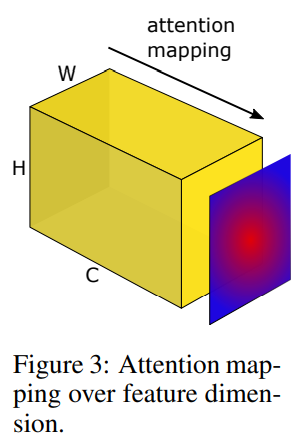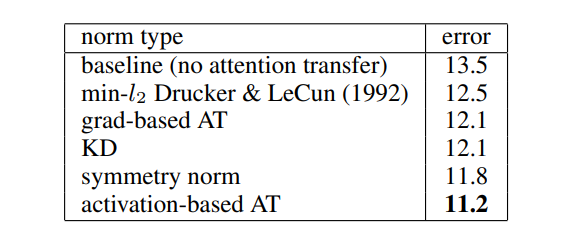【Attention Transfer】paying more attention to attention¶
论文名:Paying more attention to attention: improving the performance of convolutional neural networks via Attention Transfer
接受:ICLR2017
解决问题:为了提升学生网络的性能。
解决方案:提出了transferring attention, 目标是训练出的学生模型不仅预测精度更高,而且还需要让他们的特征图与教师网络的特征图相似。
介绍¶
有关注意力的一个假设:
-
非注意力视觉过程可以用于感知整体场景,聚合高层信息,可以用于控制注意过程,引导到场景的某个部分。
-
但是不同的视觉系统的观察角度可能不相同,如何利用注意力信息来提升性能是一个值得研究的问题。
-
更具体来讲如何使用教师网络来提升其他学生网络的性能。
注意力选择方面:AT选择使用空间注意力图,空间注意力图具有更高的可解释性。同时网络不同阶段的特征图拥有者捕获底层、中层、高层的表征信息。具体来说可以划分为:
-
activation-based spatial attention maps
-
gradient-based spatial attention maps
本文具体贡献:
-
提出使用attention作为迁移知识的特殊机制。
-
提出同时使用activation-based 和 gradient-based spatial attention maps
-
实验证明可以有一定的提升,并且要比full-activation transfer性能更好,可以与KD相结合。
Attention Transfer¶
1. Activation-based Attention Transfer¶
使用一个转换,可以将三维特征图转化为一维的HxW的空间特征图

具体来说有几种实现方案:
-
求和:F_{\mathrm{sum}}(A)=\sum_{i=1}^{C}\left|A_{i}\right|
-
求P范数(p>1):F_{\text {sum }}^{p}(A)=\sum_{i=1}^{C}\left|A_{i}\right|^{p}
-
求max P范数(p>1): F_{\max }^{p}(A)=\max _{i=1, C}\left|A_{i}\right|^{p}
对activation map进行可视化:

那么在哪个地方施加注意力?对应阶段!

具体计算公式:
L(ws,x)是交叉熵公式,Q代表对应层的attention maps,第二项使用的是L2范数。
ps:如果空间特征图尺寸不匹配,会采用插值的方式保持一致。所以这启发我们可以使用通道注意力,虽然可解释性没那么强,但是扩展性好。
2. Gradient-based Attention Transfer¶
将注意力定义为梯度,也即输入,可以被视为input sensitivity map。按照以下公式定义教师网络和学生网络梯度:
为了让两者梯度尽可能相似,使用以下loss:
那么对应的梯度计算如下:
实验部分¶



实现¶
网络forward实现:o是最终embedding,g0,g1,g2代表三个stage的输出结果。
def f(input, params, mode, base=''):
x = F.conv2d(input, params[f'{base}conv0'], padding=1)
g0 = group(x, params, f'{base}group0', mode, 1)
g1 = group(g0, params, f'{base}group1', mode, 2)
g2 = group(g1, params, f'{base}group2', mode, 2)
o = F.relu(utils.batch_norm(g2, params, f'{base}bn', mode))
o = F.avg_pool2d(o, 8, 1, 0)
o = o.view(o.size(0), -1)
o = F.linear(o, params[f'{base}fc.weight'], params[f'{base}fc.bias'])
return o, (g0, g1, g2)
KD hinton实现:
def distillation(y, teacher_scores, labels, T, alpha):
p = F.log_softmax(y/T, dim=1)
q = F.softmax(teacher_scores/T, dim=1)
l_kl = F.kl_div(p, q, size_average=False) * (T**2) / y.shape[0]
l_ce = F.cross_entropy(y, labels)
return l_kl * alpha + l_ce * (1. - alpha)
feature map l2 loss实现:
def at_loss(x, y):
return (at(x) - at(y)).pow(2).mean()
整体loss实现:
y_s, y_t, loss_groups = utils.data_parallel(f, inputs, params, sample[2], range(opt.ngpu))
loss_groups = [v.sum() for v in loss_groups]
return utils.distillation(y_s, y_t, targets, opt.temperature, opt.alpha) + opt.beta * sum(loss_groups), y_s
本文总阅读量次